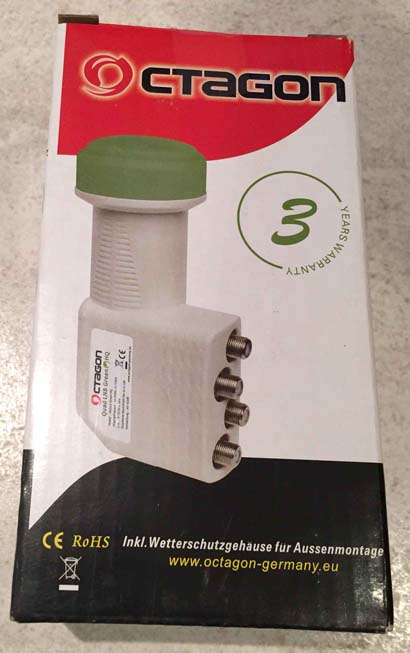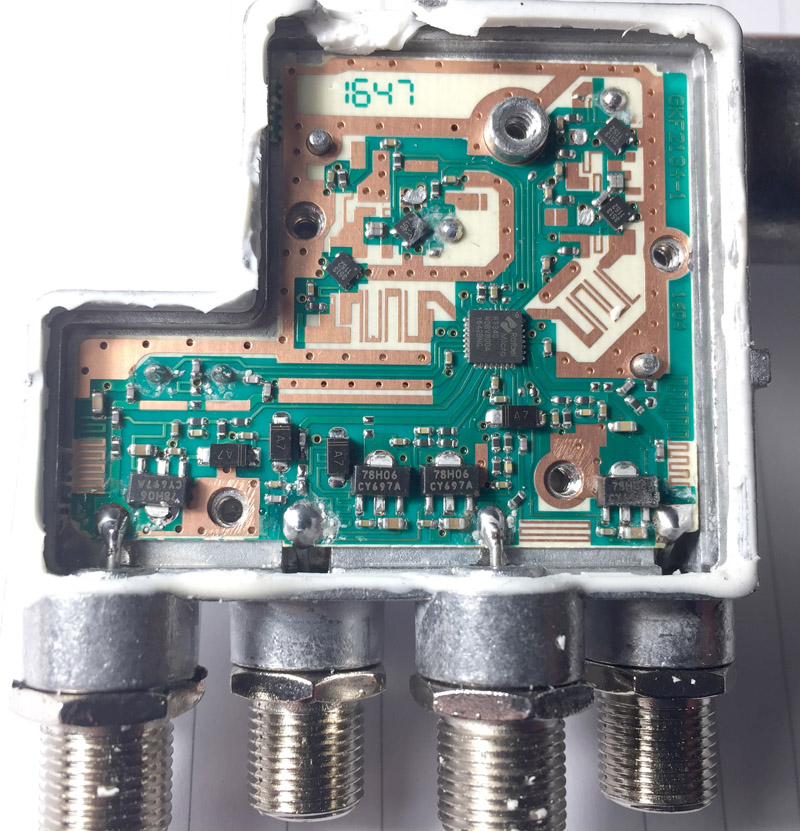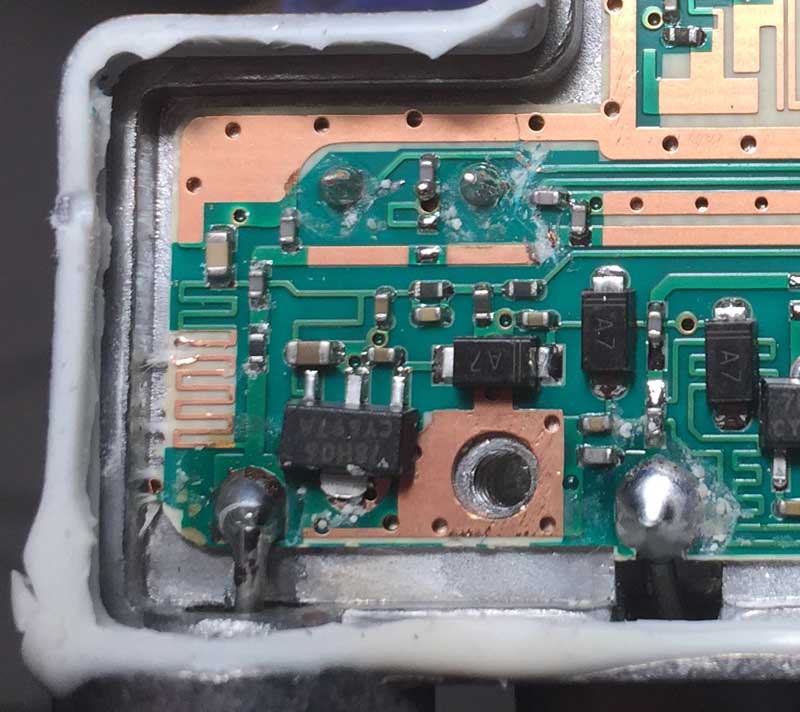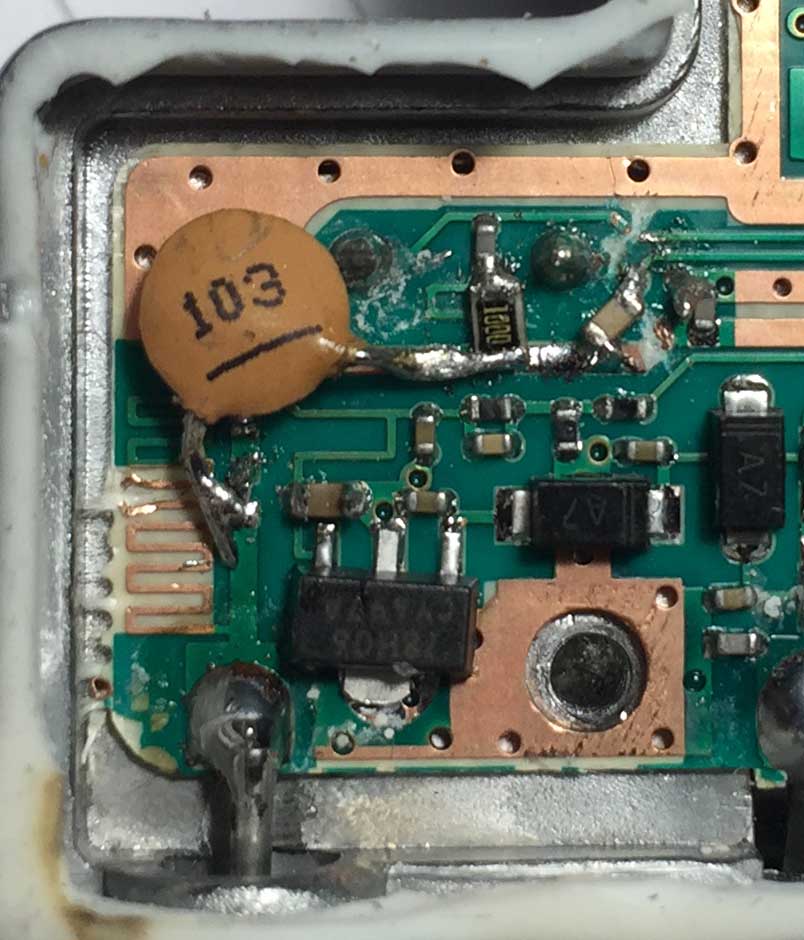Difference between revisions of "Es'hail-2 LNBs and Antennaes"
| Line 60: | Line 60: | ||
I then soldered a 10n capacitor across the old RF capacitors. I put a 100 ohm chip resistor to ground at the middle of the East-West RF track, and then a 10n chip capacitor from the East end of the RF track to the track which used to connect to the crystal. | I then soldered a 10n capacitor across the old RF capacitors. I put a 100 ohm chip resistor to ground at the middle of the East-West RF track, and then a 10n chip capacitor from the East end of the RF track to the track which used to connect to the crystal. | ||
| − | The LNB should then be tested with a 25 MHz reference. Note that it will not now operate without a reference signal. If all is | + | The LNB should then be tested with a 25 MHz reference. Note that it will not now operate without a reference signal. If all is well, the cover can be replaced. Before putting the LNB on the dish, I sealed around the cover using a neutral cure silicone sealer. Screwfix 83710 is cheap and does the job. |
===Suitable 25 MHz Reference=== | ===Suitable 25 MHz Reference=== | ||
Revision as of 15:07, 2 February 2019
Octagon LNB
References:
G4JNT's Modifications and Measurements
G4JNT's Modification for an External LO (for 27 MHz Octagon LNB)
F5XG's Dual Band Feed for Es'hail-2
HB9AFO's Modifications for an external LO on an Avenger LNB (in French)
https://www.oe7forum.at/viewtopic.php?f=7&t=284&start=135#p1519
https://www.qsl.net/zs6bte/LNB%20Test%20Results.htm
CQ-TV 261 page 36 had an article by Dave G4FRE on locking the 27MHz Octagon.
Frequency coverage and operating out of specification
G3YGF posted this on the UKmicrowave group forum:
I have measured a few of these. The earlier 27MHz dual version has about 1.2dB NF at 980MHz (bottom of tv satellite band) and at 618MHz (10368MHz), on both polarisations. Later ones are typically 1.5dB at 980MHz on either polarisation, and at 618MHz (10368MHz) about 1.5dB on the probe furthest from the backshort (V >15) and 2dB on the probe nearest the backshort (V <15v).
The 25MHz dual version is about 1.2dB at 980MHz on either polarisation, and at 618MHz 1.2dB on the probe furthest from the backshort and about 2.9dB on the probe nearest the backshort. (Measurements made using sky/ground noise). The main difference appears to be that the gain rolls off much more rapidly below the satellite band in the FET preamplifier on the probe nearest the backshort, so changing the IF makes no difference. The figures are approximate - they do vary somewhat between samples...
The measurements are on unmodified LNBs.
We use these LNBs on the FRARS EME system. Attempts to modify the LNB to interface to WG16 or different circular feeds usually lose about 0.3-0.4dB. We are currently trying to work out why... Matching screws do not improve it, so I don't think it is the Lambda-g......
Locking the Quad Octagon LNB to a 25 MHz Reference
The Octagon "Quad LNB Green" Model OQSLG Green HQ can easily be modified to run from an external 25 MHz reference fed in on one of its F-type sockets, while still providing 3 horizontal or vertical outputs. This LNB is available (Jan 2019) from Amazon UK for under £15. The item title is "Octagon 0.1db Quad High Gain HD Ready Universal LNB", but check carefully that you get the OQSLG model. The modifications described below have been done on 2 LNBs by G8GKQ.
After prising off the white plastic cover (NOT the green cap on the feedhorn), and scraping away the sealant, 5 torx screws are exposed. Undo these screws and cut around the sealant at the edge of the cover. Then using a small screwdriver in the slot at the top of the unit, lever the cover off. The PCB looks like this:
The 25 MHz crystal is mounted on the reverse side of the board, just North of the West-most 78H06 regulator. The modification involves cutting the tracks leading to the West-most output and then coupling this to the East-most crystal connection, having cut the tracks to the crystal. Use a magnifying glass, a fine knife and a fine soldering iron, taking anti-static precautions.
The track cuts can be seen here. The first is in the zig-zag inductor to cut the DC path from the socket. The second is in the RF path just South of the East-most crystal connection. The 3rd and 4th cuts are adjacent to the crystal connection.
I then soldered a 10n capacitor across the old RF capacitors. I put a 100 ohm chip resistor to ground at the middle of the East-West RF track, and then a 10n chip capacitor from the East end of the RF track to the track which used to connect to the crystal.
The LNB should then be tested with a 25 MHz reference. Note that it will not now operate without a reference signal. If all is well, the cover can be replaced. Before putting the LNB on the dish, I sealed around the cover using a neutral cure silicone sealer. Screwfix 83710 is cheap and does the job.
Suitable 25 MHz Reference
The modified LNB will run from a square wave or sine wave at 25 MHz, but needs around +6 dBm. Lower levels of reference increase the Phase noise. I used a Leo Bodnar GPS reference, with a low pass filter so that I fed a sine wave through the cable to the LNB.
The low pass filter had 5 elements, 288 pf to ground on the input, a series inductor of about 10 turns on a 4 mm core, 407 pf to ground in the centre, then another identical series inductor and 288 pf on the output.
Phase Noise
While having a stable LO might be perfect for narrow-band operation, any increase in phase noise might reduce the apparent sensitivity for DATV. I found that a 1MS DVB-S signal that gave 24 dB MER with the crystal oscillator only gave 21 dB MER with the external reference; this will need more investigation.




